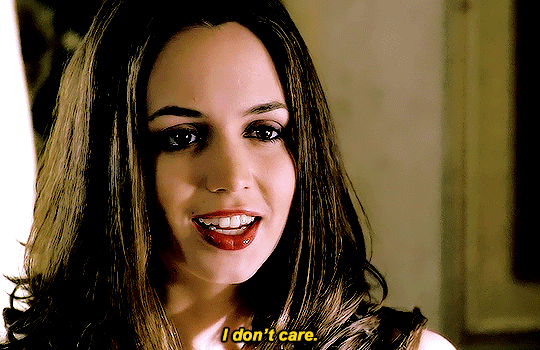Cowboy Versus Outlaw: Buffy and Faith and Good Girl, Bad Girl Tropes
Rooting for anti-heroes in Buffy the Vampire Slayer
The following article came out of our Remarkist watch party discussions of Buffy the Vampire Slayer, with input from community members @lee and @regina_13 to help us arrive at our conclusions. *Spoilers ahead!*
Does it get better than morally ambiguous anti-hero characters? There’s just something so juicy about following a shady protagonist we know we *shouldn’t* root for, yet somehow we just can’t help ourselves.
It’s like, we’re drawn to living vicariously through them, ya know? Getting our fix of illicit thrills and repressed desires without having to actually go there IRL. Or going there, no judgment! The entertainment lies in containment–we get our dose of deviance from the safety of our screens.
Cowboy vs. Outlaws
Westerns and the Alpha Male Action Movie conditioned us to see things as black and white, good guy vs. bad guy. But hello, real life has shades of gray! With her moral complexity, a character like Faith from Buffy The Vampire Slayer serves some nuance. And talk about a refreshing change from tired old cowboy vs. outlaw tropes.
Faith was the hot mess yin to Buffy’s at times vanilla yang. A blue-collar Southie slayer was a sexy seductress who drank hard, took what she wanted, apologized for nothing and got busy on the reg. Buffy was drawn to Faith’s “bad girl” attitude and sly humor. She leaned hard into that IDGAF transgressive freedom we secretly envy, the recklessly impulsive Slayer who let their freak flag fly. Faith tried to expose to Buffy the limitations of the “good girl” myth and keep it real.
Her “bad girl” attitude has parallels in those 90s comic “bad girls” like Vampirella–edgier and more provocative versions of classic superheroines.
When my friends and I (Emily) first started watching Buffy, we were total stans who saw Buffy as a flawless heroine who could do no wrong. We obviously rooted hard against that chaotic trickster Faith from the get-go. She was trying to steal Buffy’s friends and eventually her life when things already were on the rocks.
Rewatching Buffy now, it’s clear we’ve grown in our tolerance for complex female anti-heroes like Faith. In the days of tuning into the covert and overt narcissists of Breaking Bad, Mad Men, and Dexter and the like. Times have changed.
One of the benefits of a rewatch of Buffy in the current social climate is that we have a greater tolerance and appreciation for the female anti-hero character type. The closeted Faith fans are finally finding courage to stand in their truth! In this post-Barbie movie era, we celebrate narratives where women define themselves–and not just in relation to some hero dude. Faith has always embodied that rebellious spirit, refusing to play the compliant good girl.
Human nature has infinite shades of gray and she embodies those delicious contradictions. But this just makes Faith endlessly fascinating! Faith represents the messy parts we all have but don't feel free to express. She’s us all on a Faith Friday night after a Buffy week; “want, take, have.”
It’s wild how back then we just accepted those tired hero-villain tropes without question. But Faith’s complexity as an antihero speaks to us now. Her moral grayness reflects the messiness of real life–she keeps it real in a way Buffy’s pious perfection never can.
And while Faith’s behavior earns side-eye, it also exposes Buffy’s hypocrisies and inner darkness she tries so hard to repress. Buffy crashed a police car and fled the scene! (“Bad Girls,” S3, E14). Watching their dynamic with fresh eyes, we find our loyalties divided. Their clashes reveal so many compelling shades of gray.
Yet there’s still that painful twist where she lets Buffy’s rejection define her. Buffy dismissing Faith as “bad” sends her down a dark path of vengeance and self-destruction. It’s next level tragic.
By learning from past portrayals, creators have a chance to craft the kind of complex female lead we all need. One who celebrates the beautifully messy parts of womanhood in a real way. We love imperfect ladies–may they only become more compelling from here!
Faith is the “bad girl” who defies easy categorization and while we want to condemn her wrongdoings, we also can’t help but root for her. Her flaws simply make her more fascinating than any binary Mary Sue. Faith is no straightforward hero in shining armor. She’s a hot mess express with no ethical GPS, just trying to find meaning while morally adrift and we are here for it.
This sophisticated ethical landscape opens up compelling questions about justice, power dynamics, and human nature. Faith and Buffy blaze a trail from simplistic Lawman/Cowboy vs. Outlaw tradition into the more intriguing complexities of Gothic genre storytelling.
Sexuality and the “Bad Girl”
While her darkest times are hard to swallow via the Buffy Good/ Faith Bad Cowboy paradigm, history gives us some perspective. The parallels between Faith and Victoria from the gothic novel Zofloya are uncanny! Both start out seeming chill but spiral into moral ambiguity fueled by their rebellious spirit. Watching these girls struggle with their violent tendencies and dark desires is very compelling.
Victoria channels major Faith energy as a female anti-hero living in those contradictions between light and dark. The violence, lust, and ethical erosion is too real. Like Faith, Victoria is tempted by power’s corruptive influence. Her desire for total freedom leads her down a questionable path, giving in to her inner demons.
They boldly reject tradition, embracing the chaotic, transgressive freedom that feels so taboo for women. Victoria and Faith are complex females leading with their id, not their ladylike superego. We have to stan!
Faith’s open sexuality deviated big time from ‘90s-00s purity culture’s chastity and virtue ideals for young women. Where Buffy has cautious intimacy, Faith pursues physical pleasure unapologetically on her own terms. Somehow Xander gets a pass for saying the same things.
Yet subtle disapproval surrounds Faith’s sensuality, especially from Buffy. Her aggressive sexuality is framed as more reckless defiance of traditional femininity. Meanwhile Buffy’s physical connections appear more emotionally driven–Faith just lacks that deeper romantic motivation. And Buffy gets a little judgy about it.
Under the “girl power” veneer, Buffy still upholds those “good girl” normative traditions about sex. Faith’s bold, shame-free sensuality challenges that. Her attitude presents an alternative model of feminine strength fully owning desire on its own merits.
Faith’s refusal to be shamed highlights the lingering purity culture that would restrain even “liberated” heroines like Buffy. By making Faith’s sexuality core to her identity, the show complicates the tired Madonna trope. She expands the scope of female sexuality depicted at the time, defying narrow categorization.
Faith’s message to Buffy is that women have as much capacity for unapologetic desire as men. Their sexual agency deserves applause, not judgment or slut-shaming. True empowerment means honoring feminine sexuality in all its diverse expressions without imposing artificial ideals about purity.
Her rebellious spirit and violent tendencies evoke the inner torment and lack of restraint that define a Gothic anti-hero. She’s a poster child for the psychological unrest we all experience but don't feel free to express in a black-and-white world.
It’s exhausting rooting for the anti-hero
In Season 3’s “Revelations,” Faith is betrayed by her Watcher, Gwendolyn Post, then iced out of the Scoobies’ Angel secret until Xander spills. To her, it’s yet another person she dared to trust who stabs her in the back. Or doesn’t deem her worthy of truth.
When Buffy finally comes clean at the end, Faith’s over it: “I'm on my side, that's enough.” Her face shows real hurt as Buffy leaves. Faith calls her back but all she can say is “nothing,” shutting down instead of opening up.
These seeds of betrayal bloom into her later turn against Buffy. She’s conditioned to expect exclusion, so she acts to avoid being left out in the cold again. Faith preemptively isolates herself, rejecting bonds before they can reject her.
It’s tragic; underneath Faith just wants to be deemed worthy of trust and intimacy. Her walls come from profound fear of vulnerability after repeated betrayals. If only Buffy could earn back her trust, Faith could begin to heal. But hurt people hurt people, and trauma distorts our perceptions.
At Remarkist we’ve talked about the first time we saw Wes Anderson’s The Life Aquatic. For many it just kept getting harder and harder to root for the protagonist’s revenge as things get darker and spiral out of control, yet quirky presentation and score and charisma kept us on board (if conflicted.) Rooting for the anti-hero as we imagine Faith as the titular Vampire Slayer is a similar challenge.
From her fiery entrance, Faith pulls us in like she attracts the Scoobies–with that shocking authenticity that makes you feel all the feels. Her zest is infectious. But then her revenge mission takes you places that test your allegiance.
Yet every vulnerable moment reveals Faith’s brokenness and raw need for true acceptance. We long to see her redemption, to return to being “five by five” with Buffy.
Faith represents the seductive appeal and ethical challenge of the charismatic anti-hero. We can't condone her actions, but complexity keeps us invested. Under the chaos lies a hurting human just seeking connection.
This emotional nuance is precisely why Faith intrigues us. She keeps it real–even the most troubled souls contain multitudes beyond labels of “good” or “bad.” With understanding, we keep rooting for their humanity to prevail. And when it does, it gives hope to the rebels in us all.
The Accident
Faith’s insecurities left her open to the dark thrills of slaying. Her moral slide goes to the next level when she accidentally kills a human.
From Faith’s view, Buffy projects her own slayer dilemma with Ted onto the situation. Buffy turns away first, leaving Faith adrift. This sparks their slayer rivalry culminating in the Freaky Friday swap.
No doubt Faith does shady stuff, but her complexity makes her endlessly compelling. She adds juicy shades of gray to Buffy’s black-and-white perspective.
When Faith accidentally ends a human life, it creates ethically ambiguous slayers’ dilemmas. Dusting vamps: easy. But human death is morally murky, resisting neat resolution. Buffy’s reaction shows how messy and gray this situation is. At first she defaults to black-and-white justice, ready to narc Faith out to the Council.
But hello–Buffy’s not exactly innocent here either! She also abuses her power with Faith, harming police officers to avoid jail, never checking to see if they survived the crash, just making sure she doesn’t see her name in the paper or get caught.
And she fails to really empathize with Faith’s inner turmoil post-accident. Let’s get real–Buffy totally backs Faith into a corner here, presenting a false binary: either confess to the Council or accept Buffy’s judgment. When Faith says “I don’t care,” we know that’s not the full truth.
Buffy admonishes Faith for letting her impulsivity go too far, insisting she own up to killing a man and face consequences. But Faith’s response, “I don’t care,” has more nuance than just reckless indifference. It’s an ingrained childhood trauma response when cornered, when she’s obviously too freshly re-traumatized to talk about something. But Buffy won’t take a damn hint.
This scene where Faith says “I don’t care” often gets taken out of context to villainize her. It’s what the recaps pushed on our remembrance and what the script-readers shout on message boards. And the network used the clip relentlessly out of context on the “previously on” vignettes, shamelessly simplifying complex trauma. But there’s more going on beneath that badass facade. Faith’s drowning in denial and self-hatred–she can’t face her guilt. She can’t bear to face what she’s done and has to put on a tough girl facade to avoid trusting Buffy with her feelings. Faith says,
“See, you need me to toe the line because you’re afraid you’ll go over it, aren’t you, B? You can’t handle watching me living my own way, having a blast, because it tempts you! You know it could be you!”
At Remarkist, we rewatched this episode and saw that in the moment Faith indeed does care. She reacts to the body in grief and remorse, in a touching display of despair. She has no audience for this show of guilt. She has zero remorse when she is caught stealing, in contrast.
Real talk: two Slayers circling each other’s orbits may be an issue on a mystical level. Their pull is meant to shape the world, not get polarized against each other. It gets too intense when all that power turns inward.
Similarly, in Carmilla, the OG Gothic vamp tale, Carmilla’s silent kiss before biting Laura shows the magnetic yet destructive draw between them. Her love and bloodlust for Laura are twisted together.
There are echoes of that dangerous intimacy in Buffy and Faith’s charged dynamic. When rejected by Buffy, Faith literally puts herself in jail trying to make it right. That magnetic pull persists even when it’s destructive.
Maybe the show never spelled this out, but the parallels are thought-provoking. Two Chosen Ones unleash unsafe levels of volatility when focused on each other rather than the world. Their powers amplify the Gothic undertones of these tortured feminine bonds.
Not to get too “armchair slay-cologist” here but Buffy is likely using the momentum of the situation to individuate from Faith’s magnetic pull, after being controlled by her charisma like her puppet, as that telling marionette dance shot moment in the Bronze symbolized. (“Bad Girls,” S3, E14).
Faith can’t trust Buffy with her feelings, so she does the toxic tough girl facade. In the next episode, “Consequences,” Buffy says, “That’s not your real face, and I know it. I know what you’re feeling because I feel it too.”
But healing is nuanced, something both of these damaged women struggle with. Under the bravado, Faith is begging for help from someone drowning in pain. Buffy’s desire to get back her autonomy and potentially some unprocessed resentment, blinds her to Faith’s shades of gray.
Her method of processing the trauma is deeply informed by Buffy’s individuation attempt. She tries to concoct a narrative that appeals to Buffy’s ability to define what a Slayer is “outside of the Watchers Council.” That they are above the law. She’s giving Buffy an on-ramp to staying friends and slaying together without doing hard time or playing into Buffy’s guilt-trip.
Faith’s trauma and likely borderline personality disorder has created defense mechanisms that actively keep her from ever experiencing guilt or shame. So could she possibly admit guilt and stand before a jury of her peers or other watchers? She’d have to completely deconstruct herself before she could turn herself in. And this is her downward spiral. Does this excuse her actions? No. But context matters. Buffy fails to see Faith’s reaction to murdering a person as a cry for help from someone in intense pain. Instead of support, she gives an ultimatum. Their communication has broken down. But the seeds of understanding are there if only Buffy could see past the binary of righteous slayer versus chaotic impostor.
Faith’s Remorse
Buffy fandom tends to blow past the moment when Faith actually sees the human man she killed. When he didn’t dust, the finality of death hit her hard. The grief and despair on her face are so wrenching. This isn't about being caught or feeling sorry for herself. She cares. She’s devastated she took a life.
When she first told Buffy “I didn't know, I’m sorry,” her remorse was raw and real. Does she have to go to jail to appease society? Well, society doesn’t even know–as she said: no body, no crime. Her guilt and need for redemption are inner promptings, not external forces. Buffy flees. Where Faith is from, South Boston, a true friend helps you bury the body (metaphorically of course).
In that private moment of mourning, before hiding the evidence. Faith’s facial expressions take us on a damn journey, showing the depth of her humanity when no one was watching. Under the bravado, she’s drowning in sorrow and self-recrimination. It’s a profound glimpse into her complex emotional reality so often obscured. She cares.
Buffy feels compelled to betray Faith’s secret to Giles, yet never confesses her own shady behavior from that night. Should Slayers face consequences for accidentally killing humans? Does Buffy’s lack of compassion implicate her too? The writers leave it open and so the viewer’s paradigm decides for them.
Like Buffy, Giles mistakes Faith’s unwillingness to publicly show remorse as a symptom of her personality disorder and past trauma (many with borderline personality disorder have had their apologies weaponized against them at a young age and therefore cannot confess to transgressions later in life). The way he vilifies her as unstable who did the same things…smh.
We also tend to forget the fact that Giles takes Faith’s side! Imagine if he had been with her to see her initial moment of processing.
BUFFY: “It’s not all her fault, Giles. We both thought it was a vamp. I only realized a second before–”
GILES: “Buffy, this is not the first time something like this has happened. A slayer is on the front lines of a nightly war, Buffy. It’s tragic, but accidents have happened. The council investigates, meters out punishment if punishment is due. I’ve no plan to involve them, however. That’s the last thing Faith needs right now. She’s unstable, Buffy.”
Faith remains haunted, unable to move past defining herself in relation to Buffy. Her redemption requires knowing herself apart from those codependent hero/villain identities. Only through reconstructing an independent sense of self can she find her moral center again. Her struggles shine a light on the intricate psyches of Gothic archetypes.
It would’ve been easy to write Faith off after her deadly accident. Buffy suggests counseling over jail time. But Angel, likely projecting, insists she’s acquired a “taste for blood” and may kill again. And that fear plays out when Faith’s breathplay with Xander goes too far.
With care and guidance, Faith could reorient herself. But she’s denied that chance by those who see her as monstrous. This only feeds her self-loathing and pushes her further down a dark path. But it’s unfair to say she’s fundamentally corrupted now. She’s still a young, traumatized girl looking for meaning. Her remorse is real, even if her coping mechanisms are destructive.
The situation echoes The Monk by Matthew Lewis. That 18th Century gothic novel explores a monk’s descent into depravity and sin, just as Angel fears Faith spiraling into immorality. It’s tragic, but realistic; trauma and stigma can warp our moral compass. But like The Monk explores, our humanity persists if given room to heal. Faith reminds us that darkness leaves scars, yet redemption remains possible when met with compassion.
Slayer Betrays Slayer Who Was going to Betray the Slayer
Buffy rejects Faith as her co-slayer sister. After their attempt to reconcile, Faith reads Buffy’s stance accurately. Faith knew Buffy was going to betray her before Buffy did, so she beat her to the punch. Buffy was still able to turn Giles and Angel against Faith so nothing came of it.
Once Buffy weaponizes the tremendous power of her judgment to label Faith as “bad,” the Mayor masterfully exploits that deep loyalty and longing for acceptance to turn Faith and try to destroy Buffy. The Mayor is a demonic father figure that manipulates Faith in brutal fashion.
Ever the id-chaser, Faith might quote Taylor Swift and say, “they say I did something bad, so why does it feel so good?” Also in the words of Taylor Swift, the uncontested queen of the anti-hero vengeance ballad (“Better Than Revenge,” “mad woman,” “Vigilante Shit”), being labeled crazy can drive you actually crazy. Buffy’s labeling of Faith as bad is all Faith can think about; she’s been emotionally stamped with a scarlet “B” by B. “Bad.” “Killer.” This starts a descent that indeed makes it exhausting to root for this anti-hero. And while it would have been simple to paint Faith as a villainous “fallen woman,” the show refuses to stay within those lines. Instead we get a deeply human portrayal of someone struggling to reconcile trauma, identity and morality. How far does someone have to go before we write them off with that scarlet B?
Faith represents the ethically murky anti-heroines at the heart of the Gothic tradition: never fully light or dark, but beautifully complex. Her character embodies the innate human capacity for both darkness and redemption. Faith doesn’t just broaden the archetype; she freaking redefines it.
Want more?
Calling all Buffy fans! Would you love to attend watch parties and other events celebrating Buffy and Angel? Come join us on our discord where you can find other Scoobies just like yourself conversing daily about these shows and the Buffy movie. Check back here all month for content on your favorite slayer and vampires, and follow us on Instagram for exclusive slayer content!















